Shumaila Javaid
Eco-Friendly 0G Networks: Unlocking the Power of Backscatter Communications for a Greener Future
Nov 20, 2024Abstract:Backscatter Communication (BackCom) technology has emerged as a promising paradigm for the Green Internet of Things (IoT) ecosystem, offering advantages such as low power consumption, cost-effectiveness, and ease of deployment. While traditional BackCom systems, such as RFID technology, have found widespread applications, the advent of ambient backscatter presents new opportunities for expanding applications and enhancing capabilities. Moreover, ongoing standardization efforts are actively focusing on BackCom technologies, positioning them as a potential solution to meet the near-zero power consumption and massive connectivity requirements of next-generation wireless systems. 0G networks have the potential to provide advanced solutions by leveraging BackCom technology to deliver ultra-low-power, ubiquitous connectivity for the expanding IoT ecosystem, supporting billions of devices with minimal energy consumption. This paper investigates the integration of BackCom and 0G networks to enhance the capabilities of traditional BackCom systems and enable Green IoT. We conduct an in-depth analysis of BackCom-enabled 0G networks, exploring their architecture and operational objectives, and also explore the Waste Factor (WF) metric for evaluating energy efficiency and minimizing energy waste within integrated systems. By examining both structural and operational aspects, we demonstrate how this synergy enhances the performance, scalability, and sustainability of next-generation wireless networks. Moreover, we highlight possible applications, open challenges, and future directions, offering valuable insights for guiding future research and practical implementations aimed at achieving large-scale, sustainable IoT deployments.
LoRa Communication for Agriculture 4.0: Opportunities, Challenges, and Future Directions
Sep 17, 2024Abstract:The emerging field of smart agriculture leverages the Internet of Things (IoT) to revolutionize farming practices. This paper investigates the transformative potential of Long Range (LoRa) technology as a key enabler of long-range wireless communication for agricultural IoT systems. By reviewing existing literature, we identify a gap in research specifically focused on LoRa's prospects and challenges from a communication perspective in smart agriculture. We delve into the details of LoRa-based agricultural networks, covering network architecture design, Physical Layer (PHY) considerations tailored to the agricultural environment, and channel modeling techniques that account for soil characteristics. The paper further explores relaying and routing mechanisms that address the challenges of extending network coverage and optimizing data transmission in vast agricultural landscapes. Transitioning to practical aspects, we discuss sensor deployment strategies and energy management techniques, offering insights for real-world deployments. A comparative analysis of LoRa with other wireless communication technologies employed in agricultural IoT applications highlights its strengths and weaknesses in this context. Furthermore, the paper outlines several future research directions to leverage the potential of LoRa-based agriculture 4.0. These include advancements in channel modeling for diverse farming environments, novel relay routing algorithms, integrating emerging sensor technologies like hyper-spectral imaging and drone-based sensing, on-device Artificial Intelligence (AI) models, and sustainable solutions. This survey can guide researchers, technologists, and practitioners to understand, implement, and propel smart agriculture initiatives using LoRa technology.
Large Language Models for UAVs: Current State and Pathways to the Future
May 02, 2024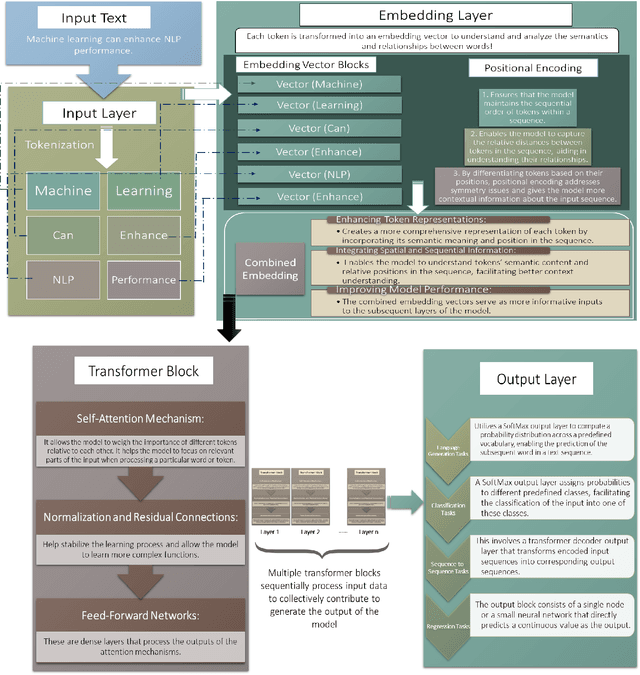
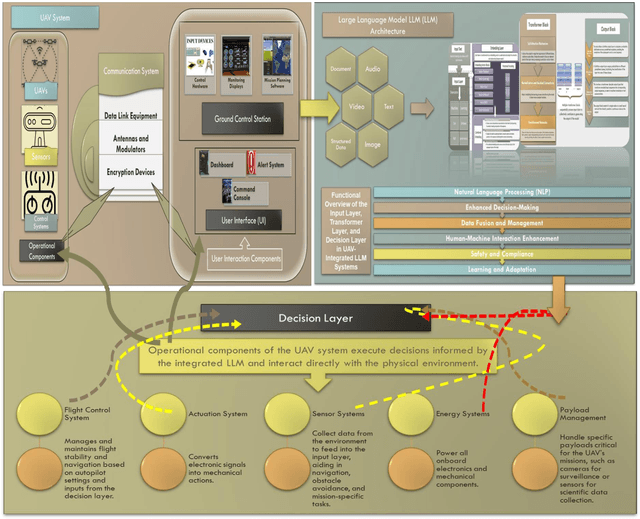
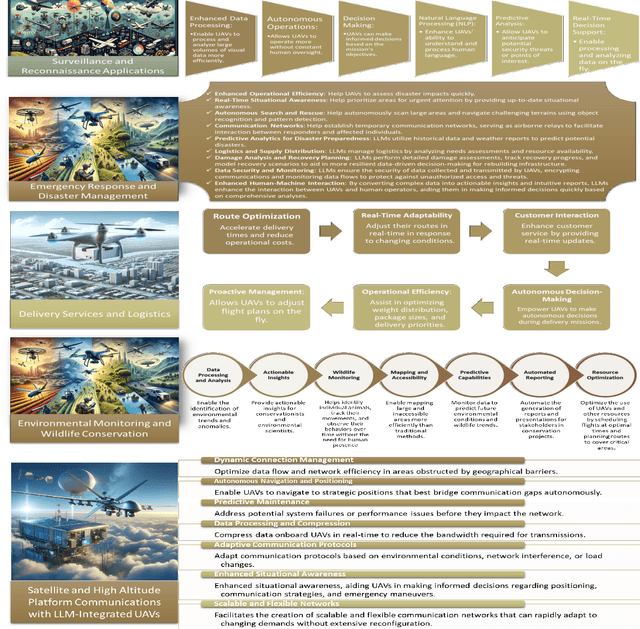
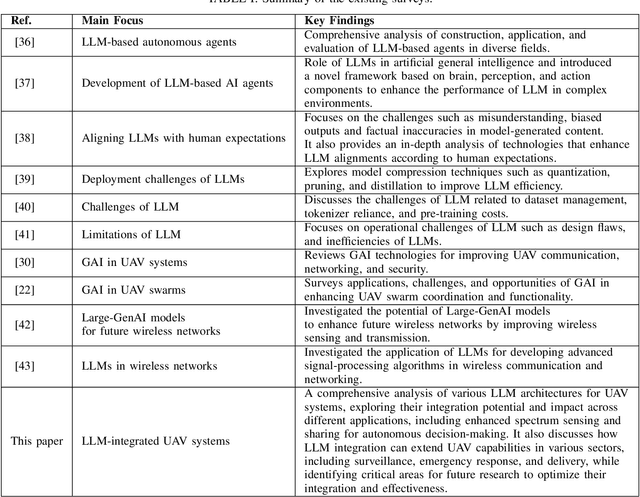
Abstract:Unmanned Aerial Vehicles (UAVs) have emerged as a transformative technology across diverse sectors, offering adaptable solutions to complex challenges in both military and civilian domains. Their expanding capabilities present a platform for further advancement by integrating cutting-edge computational tools like Artificial Intelligence (AI) and Machine Learning (ML) algorithms. These advancements have significantly impacted various facets of human life, fostering an era of unparalleled efficiency and convenience. Large Language Models (LLMs), a key component of AI, exhibit remarkable learning and adaptation capabilities within deployed environments, demonstrating an evolving form of intelligence with the potential to approach human-level proficiency. This work explores the significant potential of integrating UAVs and LLMs to propel the development of autonomous systems. We comprehensively review LLM architectures, evaluating their suitability for UAV integration. Additionally, we summarize the state-of-the-art LLM-based UAV architectures and identify novel opportunities for LLM embedding within UAV frameworks. Notably, we focus on leveraging LLMs to refine data analysis and decision-making processes, specifically for enhanced spectral sensing and sharing in UAV applications. Furthermore, we investigate how LLM integration expands the scope of existing UAV applications, enabling autonomous data processing, improved decision-making, and faster response times in emergency scenarios like disaster response and network restoration. Finally, we highlight crucial areas for future research that are critical for facilitating the effective integration of LLMs and UAVs.
Communication and Control in Collaborative UAVs: Recent Advances and Future Trends
Feb 23, 2023Abstract:The recent progress in unmanned aerial vehicles (UAV) technology has significantly advanced UAV-based applications for military, civil, and commercial domains. Nevertheless, the challenges of establishing high-speed communication links, flexible control strategies, and developing efficient collaborative decision-making algorithms for a swarm of UAVs limit their autonomy, robustness, and reliability. Thus, a growing focus has been witnessed on collaborative communication to allow a swarm of UAVs to coordinate and communicate autonomously for the cooperative completion of tasks in a short time with improved efficiency and reliability. This work presents a comprehensive review of collaborative communication in a multi-UAV system. We thoroughly discuss the characteristics of intelligent UAVs and their communication and control requirements for autonomous collaboration and coordination. Moreover, we review various UAV collaboration tasks, summarize the applications of UAV swarm networks for dense urban environments and present the use case scenarios to highlight the current developments of UAV-based applications in various domains. Finally, we identify several exciting future research direction that needs attention for advancing the research in collaborative UAVs.
Neural Networks for Infectious Diseases Detection: Prospects and Challenges
Dec 07, 2021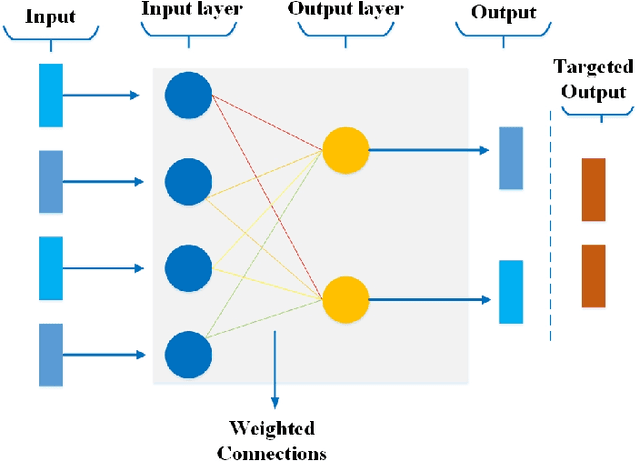
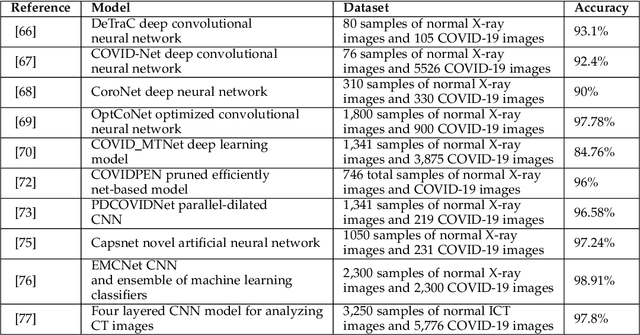
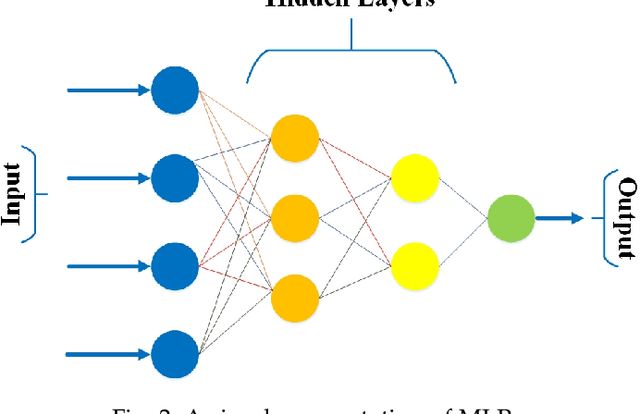

Abstract:Artificial neural network (ANN) ability to learn, correct errors, and transform a large amount of raw data into useful medical decisions for treatment and care have increased its popularity for enhanced patient safety and quality of care. Therefore, this paper reviews the critical role of ANNs in providing valuable insights for patients' healthcare decisions and efficient disease diagnosis. We thoroughly review different types of ANNs presented in the existing literature that advanced ANNs adaptation for complex applications. Moreover, we also investigate ANN's advances for various disease diagnoses and treatments such as viral, skin, cancer, and COVID-19. Furthermore, we propose a novel deep Convolutional Neural Network (CNN) model called ConXNet for improving the detection accuracy of COVID-19 disease. ConXNet is trained and tested using different datasets, and it achieves more than 97% detection accuracy and precision, which is significantly better than existing models. Finally, we highlight future research directions and challenges such as complexity of the algorithms, insufficient available data, privacy and security, and integration of biosensing with ANNs. These research directions require considerable attention for improving the scope of ANNs for medical diagnostic and treatment applications.
 Add to Chrome
Add to Chrome Add to Firefox
Add to Firefox Add to Edge
Add to Edge